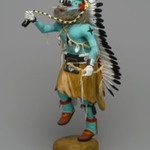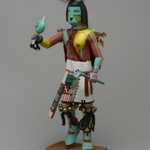![probably Henry Shelton (1929–2016). <em>Kachina Doll (Kwahu [Eagle])</em>, 1960–1970. Cottonwood root, acrylic pigment, feathers, yarn, leather, 19 1/2 x 27 x 5 in. (49.5 x 68.6 x 12.7 cm). Brooklyn Museum, Gift of Edith and Hershel Samuels, 2010.6.13. Creative Commons-BY (Photo: Brooklyn Museum, CUR.2010.6.13.jpg)](https://d1lfxha3ugu3d4.cloudfront.net/images/opencollection/objects/size2/CUR.2010.6.13.jpg)
![probably Henry Shelton (1929–2016). <em>Kachina Doll (Kwahu [Eagle])</em>, 1960–1970. Cottonwood root, acrylic pigment, feathers, yarn, leather, 19 1/2 x 27 x 5 in. (49.5 x 68.6 x 12.7 cm). Brooklyn Museum, Gift of Edith and Hershel Samuels, 2010.6.13. Creative Commons-BY (Photo: Brooklyn Museum, CUR.2010.6.13.jpg)](https://d1lfxha3ugu3d4.cloudfront.net/images/opencollection/objects/size2/CUR.2010.6.13.jpg)
probably Henry Shelton (1929–2016). Kachina Doll (Kwahu [Eagle]), 1960–1970. Cottonwood root, acrylic pigment, feathers, yarn, leather, 19 1/2 x 27 x 5 in. (49.5 x 68.6 x 12.7 cm). Brooklyn Museum, Gift of Edith and Hershel Samuels, 2010.6.13. Creative Commons-BY (Photo: Brooklyn Museum, CUR.2010.6.13.jpg)
![probably Henry Shelton (1929–2016). <em>Kachina Doll (Kwahu [Eagle])</em>, 1960–1970. Cottonwood root, acrylic pigment, feathers, yarn, leather, 19 1/2 x 27 x 5 in. (49.5 x 68.6 x 12.7 cm). Brooklyn Museum, Gift of Edith and Hershel Samuels, 2010.6.13. Creative Commons-BY (Photo: Brooklyn Museum, 2010.6.13_front_PS2.jpg)](https://d1lfxha3ugu3d4.cloudfront.net/images/opencollection/objects/size2/2010.6.13_front_PS2.jpg)
probably Henry Shelton (1929–2016). Kachina Doll (Kwahu [Eagle]), 1960–1970. Cottonwood root, acrylic pigment, feathers, yarn, leather, 19 1/2 x 27 x 5 in. (49.5 x 68.6 x 12.7 cm). Brooklyn Museum, Gift of Edith and Hershel Samuels, 2010.6.13. Creative Commons-BY (Photo: Brooklyn Museum, 2010.6.13_front_PS2.jpg)
![probably Henry Shelton (1929–2016). <em>Kachina Doll (Kwahu [Eagle])</em>, 1960–1970. Cottonwood root, acrylic pigment, feathers, yarn, leather, 19 1/2 x 27 x 5 in. (49.5 x 68.6 x 12.7 cm). Brooklyn Museum, Gift of Edith and Hershel Samuels, 2010.6.13. Creative Commons-BY (Photo: Brooklyn Museum, CUR.2010.6.13_front.jpg)](https://d1lfxha3ugu3d4.cloudfront.net/images/opencollection/objects/size2/CUR.2010.6.13_front.jpg)
probably Henry Shelton (1929–2016). Kachina Doll (Kwahu [Eagle]), 1960–1970. Cottonwood root, acrylic pigment, feathers, yarn, leather, 19 1/2 x 27 x 5 in. (49.5 x 68.6 x 12.7 cm). Brooklyn Museum, Gift of Edith and Hershel Samuels, 2010.6.13. Creative Commons-BY (Photo: Brooklyn Museum, CUR.2010.6.13_front.jpg)
![probably Henry Shelton (1929–2016). <em>Kachina Doll (Kwahu [Eagle])</em>, 1960–1970. Cottonwood root, acrylic pigment, feathers, yarn, leather, 19 1/2 x 27 x 5 in. (49.5 x 68.6 x 12.7 cm). Brooklyn Museum, Gift of Edith and Hershel Samuels, 2010.6.13. Creative Commons-BY (Photo: Brooklyn Museum, CUR.2010.6.13_back.jpg)](https://d1lfxha3ugu3d4.cloudfront.net/images/opencollection/objects/size2/CUR.2010.6.13_back.jpg)
probably Henry Shelton (1929–2016). Kachina Doll (Kwahu [Eagle]), 1960–1970. Cottonwood root, acrylic pigment, feathers, yarn, leather, 19 1/2 x 27 x 5 in. (49.5 x 68.6 x 12.7 cm). Brooklyn Museum, Gift of Edith and Hershel Samuels, 2010.6.13. Creative Commons-BY (Photo: Brooklyn Museum, CUR.2010.6.13_back.jpg)
![probably Henry Shelton (1929–2016). <em>Kachina Doll (Kwahu [Eagle])</em>, 1960–1970. Cottonwood root, acrylic pigment, feathers, yarn, leather, 19 1/2 x 27 x 5 in. (49.5 x 68.6 x 12.7 cm). Brooklyn Museum, Gift of Edith and Hershel Samuels, 2010.6.13. Creative Commons-BY (Photo: Brooklyn Museum, CUR.2010.6.13_threequarter.jpg)](https://d1lfxha3ugu3d4.cloudfront.net/images/opencollection/objects/size2/CUR.2010.6.13_threequarter.jpg)
probably Henry Shelton (1929–2016). Kachina Doll (Kwahu [Eagle]), 1960–1970. Cottonwood root, acrylic pigment, feathers, yarn, leather, 19 1/2 x 27 x 5 in. (49.5 x 68.6 x 12.7 cm). Brooklyn Museum, Gift of Edith and Hershel Samuels, 2010.6.13. Creative Commons-BY (Photo: Brooklyn Museum, CUR.2010.6.13_threequarter.jpg)
![probably Henry Shelton (1929–2016). <em>Kachina Doll (Kwahu [Eagle])</em>, 1960–1970. Cottonwood root, acrylic pigment, feathers, yarn, leather, 19 1/2 x 27 x 5 in. (49.5 x 68.6 x 12.7 cm). Brooklyn Museum, Gift of Edith and Hershel Samuels, 2010.6.13. Creative Commons-BY (Photo: Brooklyn Museum, 2010.6.13_back_PS2.jpg)](https://d1lfxha3ugu3d4.cloudfront.net/images/opencollection/objects/size2/2010.6.13_back_PS2.jpg)
probably Henry Shelton (1929–2016). Kachina Doll (Kwahu [Eagle]), 1960–1970. Cottonwood root, acrylic pigment, feathers, yarn, leather, 19 1/2 x 27 x 5 in. (49.5 x 68.6 x 12.7 cm). Brooklyn Museum, Gift of Edith and Hershel Samuels, 2010.6.13. Creative Commons-BY (Photo: Brooklyn Museum, 2010.6.13_back_PS2.jpg)
Kachina Doll (Kwahu [Eagle])
Arts of the Americas
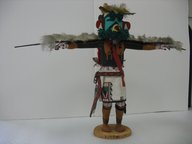
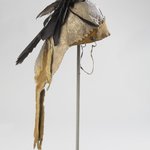

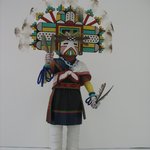

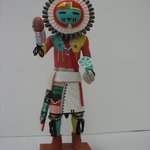

![Kachina Doll (Angwusnasomtaqa [Crow Mother])](https://d1lfxha3ugu3d4.cloudfront.net/images/opencollection/objects/size2_sq/2010.6.2_front_PS2.jpg)
![Kachina Doll (Kwahu [Eagle])](https://d1lfxha3ugu3d4.cloudfront.net/images/opencollection/objects/size2_sq/2010.6.10_front_PS2.jpg)
